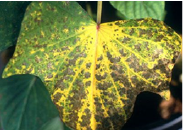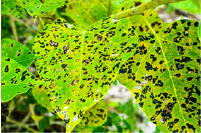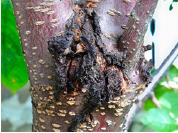
Pests and disease control in agriculture

Pests are living organisms that cause damage to crops in form of quality and quantity.
Ways by which pests cause damage the crops
- Eat the buds, flowers, shoot, fruits e.g. grasshopper, caterpillars and beetles eat leaves/cause defoliation. Reducing fruit production and rate of photosynthesis.
- Introduce toxins to plants
- They bore into fruits and seeds e.g. bean bruchid/weevil, maize weevil etc. and eat inside causing holes, discoloring the tubers and causing them to have bitter taste e.g. sweet potato weevils.
- Suck plant sap and reduce plant vigor e.g. aphids, mealybugs and scales
- Transmit diseases e.g. maize leaf hopper, white flies etc.
- Change crop’s growth habits e.g. sorghum shoot flies
- Cause discoloration and bad smell reducing acceptability by customers
- They penetrate and damage plant roots thus preventing absorption of water and nutrients
- They reduce the yield of crops.
- Cause rotting of seeds hindering germination
- Contaminate products with their excreta
Characteristics that make pests successful in nature
- Have high rate of multiplication e.g. lay very many eggs.
- Most of them are small making it easy to hide
- They resemble the host crop for easy camouflage
- Have hard cuticle to protect them from adverse conditions
- Most fly leading fast dispersal
- Have defense mechanisms such as production of offensive smell
- Undergo metamorphosis such that different stages occupy different ecological niches to reduce competition
- Develop resistance to pesticides
- Have alternative source of food
- Have modified mouth parts to feed on crops such as mandibles for cutting and proboscises for sucking
- Resistant to diseases.
Pest control measures
Principles of pest management and control
These are factors that need to be considered in order to fight a pest
- Taxonomy: identifying the pest
- Ecology the way of life of the pest to understand the effect of weather and seasons on the pest in order to identify the best time to attack the pest
- The biology: how the pest reproduces to identify the best stage to attack it.
- Estimating the population to identify the economic threshold of the pest.
Method of controlling of controlling crop pests
(a) Cultural methods of controlling crop pests
Cultural pest control refers to the manipulation of the crop production system or cultural practices to reduce or eliminate pest populations. These include: –
- Proper seed bed preparation: repeated tillage either exposes soil borne pests to their natural enemies on the surface or buries the pests very deep in the soil where they are suffocated and die.
- Crop rotation: this controls pests which feed on specific crops; by not growing such crops, pests either migrate or die due to lack of food
- Closed seasons: this involves foregoing cropping seasons without planting so as to control the build-up of pests in the field. Cropping is suspended for specific period to derive pests out of the host plants.
- Use of resistant crop varieties that tolerate pests. The resistant varieties have characteristics such as hairiness, thick or hard epidermis, unattractive color and/or smell to the pest and early maturation
- Destruction of crop residues after harvesting to eliminate breeding sites and kill the pests.
- Use of certified seeds and planting materials that carry no pests
- Regular weeding of the crops to eliminate breeding, hiding sites and alternative hosts.
- Proper spacing reduces spread of pests from one crop to another
- Proper pruning removes infected branches and micro habitats for the pests
- Thinning prevents overcrowding and spreading of pests
- Proper application of fertilizers ensures that crops grow faster or are able to tolerate pests
- Rogueing eradicates pests by removing and destroying pest affected crops from the garden.
- Mulching especially with black polythene controls nematodes in pineapple fields.
- Timely planting ensures that the crops grow and mature before destructive stages of the pest.
- Timely harvesting prevents attack of mature grains such as in millet, sorghum, rice and maize.
- Destroying volunteer plants i.e. plants that provide alternative source of food or breeding ground.
- Intercropping discourages spreading of pest from one crop to another and some crops like tobacco produce natural pest repellants.
Advantages of cultural pest control
- It is cheap and feasible for low value crops
- Does not pollute the environment
- It offers opportunity for integration of other methods
- Effect method of preventing pest establishment
Disadvantage of cultural method of pest control
- Does not eliminate pests
- Applied before pest attack thus reluctantly used
- Requires repeated use
(b) Physical methods of pest control
These involve use of specific physical/mechanical measures to reduce the number of pests. They include
- Hand picking and destruction of pests
- Construction of physical barriers e.g. greenhouse and screen houses
- Use extreme (high or low) temperatures to kill pests
- Use of radiations
- Dehydration of pest
- Use of irritating sound
- Use scarecrows
- Use insect traps
(c) Chemical pest control
It a pest control measures that involve use of chemical/pesticides. Natural chemicals used includes a mixture of urine and ash, some plant extracts etc. Synthetic chemicals include DDT, ambush, deldrine, malathion etc.
Terminologies relating use of pesticides
- Lethal dose (LD50) is the dose of agricultural chemical that will kill 50% of the pest/animal in a test population.
- Selective pesticide is one that kills only the target organism but has little effects on others.
- Pre-harvest period: it the duration/length of time which must elapse before crops sprayed with agricultural chemical can be consumed
- Persistence: the period of time a pesticide remains in the environment (including within the organism) before being broken down.
- Specificity refers to the range of organism that a pesticide can affect/kill. Broad spectrum pesticides is one that kill many species of pests such as DDT while a narrow spectrum pesticide kills few species.
- Tolerance limit refers to the maximum quantity of the chemical residues that is acceptable in the environment.
Desirable characteristics of a pesticide
- toxic to the target organism
- specific to the target organism
- biodegradable not to accumulate in the environment
- harmless to the plants and animals
- cheap and readily available
- easy to store and transport
- readily soluble in water
- not accumulate in ecosystem
Precautions to be taken by the farmers to ensure safe use of pesticides
- Read the instructions on the container or leaflet before using the pesticide
- Wear protective clothes such as overalls, gloves, rubber boots, head masks and eye shields.
- Chemical should be stored in safe places away from children.
- Do not eat or drink while working with pesticides
- Wash any spillage from your body as soon as possible
- Clean the equipment after use
- Dispose of empty containers safely as instructed by the manufacturer.
- Do not use empty containers for edible substances.
Factors that affect efficiency of a pesticide
- Concentration of the pesticide
- Timing of application or stage of the pest to which the pest is applied
- Weather conditions at the time of application. Usually rain/dew may dilute the pesticides leading to ineffectiveness.
Pesticide resistance
It is a situation where the pest population remains relatively unaffected by application of a recommended pesticide in the right quantities and concentrations. Or it is a situation where pests acquire characteristics/traits that enable them to survive despite the recommended levels of pesticides.
Factors that promote pesticide resistance in pest populations
- Genetic factors; high genetic variation promote resistance
- Mutation
- Prolonged t use of a single pesticide
- Unwarranted use of pesticides
- Use of broad spectrum pesticides such as DDT that kill natural enemies of the pests.
- Use of sub-lethal concentration of pesticides
- High population of pesticide
- Non-uniform application of pesticides in the field
Advantages of chemical pest control
- It is very effective
- Easy to apply
- Chemicals are broad spectrum
- Easy to access
Factors that limit the use of or disadvantages pesticide by farmers
- they and application equipment are expensive
- application of pesticides requires skill especially in measuring and mixing
- they kill beneficial organism as well for example pollinator.
- They pollute the environment
- They lower the value and/quality of products
- They are poisonous to the farmer and livestock
- Lead to chemical resistant pests on prolonged use of same pesticide
- Accumulate in ecosystem
- Pesticides can be poisonous to farmers and their animals
- Some pesticides are inflammable and may cause fire hazards
- Some pesticides such as DDT accumulate in food chain leading to toxic levels and may eliminate organisms in top trophic levels.
(d) Biological pest control
This is the control of the pest population below the economical threshold using their natural enemies in form of predator, pathogen, parasite etc.
Qualities of a good biological pest control agent
- Must have high searching ability
- Should be adaptable to wide range of environments
- Should be host specific
- Should have ability to multiply in order to control the target organism
- Should not cause a lot of damage to crops and animals
- Should be easily raised artificially
- Should be easy to distribute/apply
Advantages of controlling pest using biological control method
- It requires less labor
- It is selective to the target organism
- Long lasting from season to season
- Can be easily employed to remote areas
- cheap
Methods of using biological control agent
- Introduction: here the natural enemy is introduced from another area in the area of interest to control the pest.
- Conservation: the natural enemy exists but there is still an outbreak of the pest. Conservation therefore refers to the adjustment of the farming system to favor multiplication of the agents
- Argumentation: requires introduction of additional of the natural enemy to the existing population
(e) Integrated pest management (IPM)
It is a pest control measure involving use of a wide range of methods to control pests without harming the environment using methods such as biological control, burying/burning infected plant parts etc. use of chemicals is minimized.
Advantage of integrated pest management
- it reduces environmental pollution
- has less health side effects
- ensure complete destruction of the pest at all stages of development
- Conservation/protection of important insects such as bees, lady bird beetles, true spiders and rove beetles etc. is achieved.
- Pest infestation can be controlled in the a very short time i.e. quick control pest is achieved.
- In build resistance of some pest to a certain control method is eradicated more than one method is used.
- The system is cost effective in the long run.
Disadvantage of integrated pest management
- Requires skill
- Farmer are reluctant to use prevention measures
- Does not eliminate the pests
Crop diseases
A disease is any sub-normality or malfunctioning that occur in plants and becomes harmful to any part of its part or systems.
Ways by which disease spread in crops
- Through wind/air current blow spores from one diseased crop to another
- Through rain splash
- Contact between health and diseased plant
- Infected planting materials/seedlings/cuttings
- Pruning knives, pangas carry disease causing organisms
- Transfer of disease causing organisms by pests and vectors
- Irrigation with contaminated water
- Application of infected mulches
- Through infected crop wastes/residues
- Through infected organic manure
- Through contact with infected animals
Methods that can be used to control crop diseases
- Plant resistant/tolerant plants to diseases
- Timely weeding to remove alternative hosts or breeding grounds
- Crop rotation to prevent building up host specific diseases
- Spraying with recommended chemicals to control vectors or to kill disease causing agents
- Seed dressing can be used to destroy spores on the seeds
- Heat treatment can be used to destroy spores on the seeds.
- Sterilizing soil by heat to kill pathogens
- Early planting to escape buildup of pests and diseases
- Proper spacing to minimize spreading of diseases
- Quarantine to restrict movement of diseased plant materials
- Destruction of crop residues that contain pathogens
- Pruning to reduce micro-climate that favor growth of microorganisms
- Disinfect tools to prevent spread of diseases
- Proper hygiene
Symptoms of plant disease
- Mosaic: these are yellow patches on the leaves forming a mosaic pattern, followed by leaf curling. They are caused by viruses e.g. cassava and tomato mosaic.

- Rusts: these are rusty orange/white colored sports that result in rupturing of the epidermis and formation of swellings. They are caused by fungi that attack leaves and stems e.g. coffee rust, bean rust

- Smuts are black dusty masses that resemble soot normally found in cereals like maize, wheat, sugar cane and sorghum. They are caused by fungi.

- Anthrocnose are small sunken water soaked lesions on leaves, stems and ponds. They caused by fungi e.g. bean anthrocnose.

- Rots are degeneration of plant tissues due attack by pathogens. They are common in vegetables and fruits

- Rosette occurs in leaves and makes the leaves to be grouped closely and packed together with limited spaces and there appears to be no internodes. E.g. groundnut rosette cause by viruses.

- Galls are swellings along the structure of a plant that may interfere with transportation and absorption of water and nutrients. They are caused by nematodes and fungi.

- Chlorosis is the uniform yellowing of leaves

- Necrosis is the death of plant tissues resulting from attack by pathogens.

- Wilts: plant tissues become flaccid and drop/collapse caused by fungi.

- Leaf spot and blights are limited non-expanding necrosis patches on leaves. If the spots are fast spreading, they kill the whole part of the plant and become blights.

- Dumping off is the rotting or collapse of the seedlings at the ground level. It is caused by fungi.

Dumping is promoted by
- Heavy soil/poor drainage
- Very high plant population
- Heavy weed infestation
- Excess soil moisture and nitrogen
- Mildew is the massive production of spores and mycelia that rapidly covers the leaf surface producing a powdery substance e.g. downy mildew.

- Cankers are wounds created on plant tissue due to attack by pathogens

- Hypotrophy is the production of small sized cells induced by pathogens.
- Hypertrophy is the abnormal increase in the size of the plant organsdue to increase in the size of the cells of a particular tissue
- Hyperplasia is the abnormal increase in the size of the plant organs due to increase in the number of cells of which the tissue or organ is composed, owing to increased cell division.
- phyllody is the abnormal development of floral parts into leafy structures
- Mottling is the yellowing of leaves but with no pattern.
The environmental factors that cause diseases in plants
(a) Temperature
- Sun scald exposed sites of fresh fruits and vegetables
- Wilting due to high evaporation
- Over sweetening of potatoes due to low temperature
(b) Soil
- Cause stunted growth due to inadequate nutrients
- Increase yellowing and leaf senescence due to lack of water
(c) Rotting due to much water
(d) Chlorosis and early senescence due to inadequate supply of nitrogen
(e)Lack of soil moisture cause wilting and stunted growth
(d) Limited sunshine/shadows causes etiolation and weakening of plant stems
(f) Air pollutants such as sulphur dioxide cause plant lesions
The nursery bed maintenance and how they can contribute to pest management
- Irrigation and water leads to healthy seedlings that can tolerate pests.
- Appropriate and regular watering wash off pests from seedlings
- Weeding eliminate weeds that act as breeding ground for pests
- Thinning reduces congestion and spread of pests
- Monitoring and picking out infected seedlings prevents spread of pests and diseases
- Spraying kills pesticides
- Application of fertilizers boot seedlings vigour which help them to tolerate pests and diseases
- Soil sterilization by heating soil kills pest
Factors that make fungi the most successful plant pathogens
- They have wide range of host
- They are saprophytic in nature and thus have food available
- Produce vast amount of spores to increase chance of survival
- Light spore is easily dispersed
- Can exist in different forms
- Readily undergo mutation
- Resistant to chemicals
Dr. Bbosa Science

Thanks for being a beacon of knowledge. Sports Fitness & Outdoor
Your content is a real gem. Tech News
Learn about the competitive MBBS Cutoff Of Private Medical Colleges in Delhi for top-ranked institutions.
Learn about the qualifying scores for top colleges at MBBS Cutoff Of Private Medical Colleges in West Bengal.
Stay updated with the latest features through the Raja Luck App Download.
Get a fresh perspective on Raja Luck today.
If you’re dealing with SEO, comprehending Backlink Strategy is a game-changer.
Use natural and ethical approaches to Get Backlinks for My Website.
Open amazing gaming opportunities with Raja-Luck and experience thrilling lottery game video games.
Join the most interesting video gaming platform with the Goa Games Invite Code.
Broaden your data processing abilities with premium Server Rental in Mumbai.
I don’t think the title of your article matches the content lol. Just kidding, mainly because I had some doubts after reading the article.
Exceptional review on Nainital’s destinations! For evening social strategies, Escort Service In Nainital can organize wonderful business.
The user interface of bdg win is smooth, making it easy to play anytime.
Keep track of Rajasthan Royals’ project with the complete **RR IPL 2025 Schedule**, consisting of match details and timings.